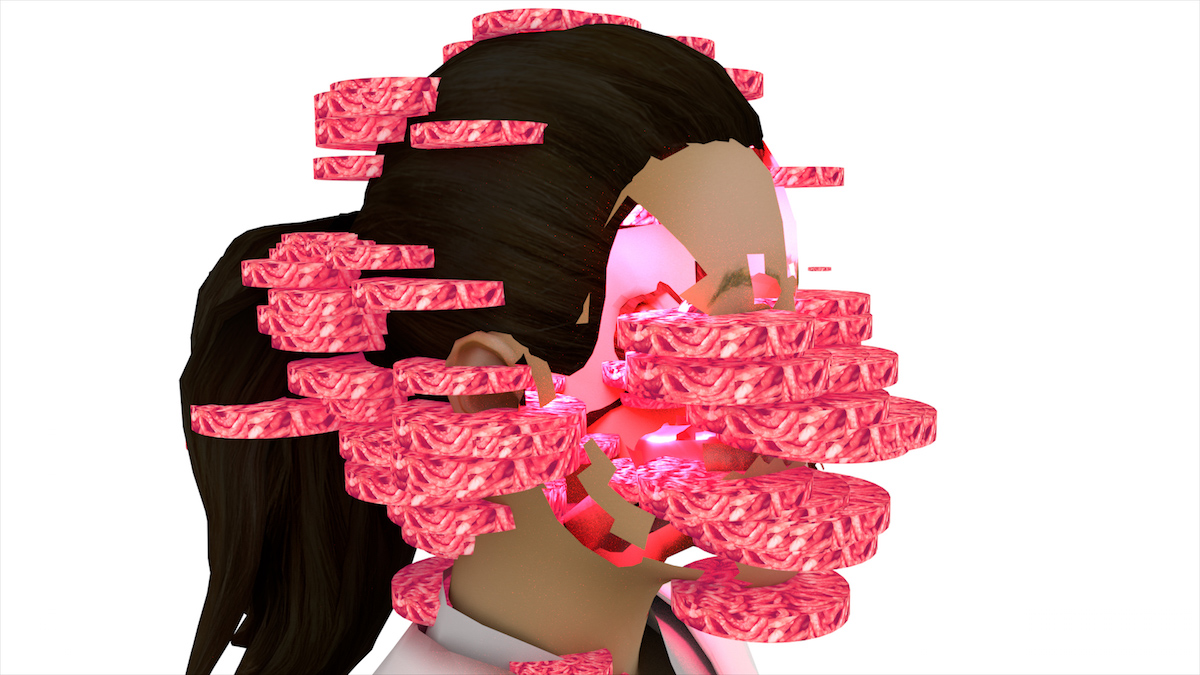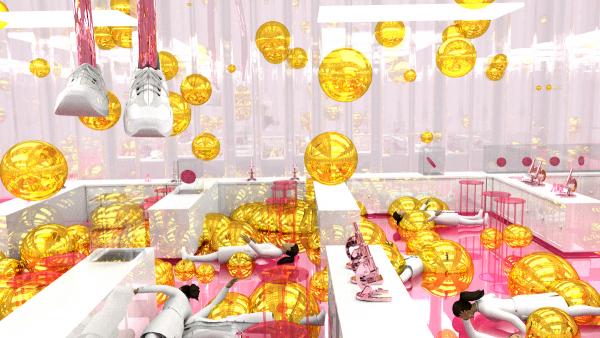Last summer Art + Technology Lab grant recipient Jen Liu teamed up with graduate students from the Media Design Practices MFA program (MDP) at ArtCenter College of Design to plan and fabricate sculptural components of her project Pink Slime Caesar Shift. Liu's project incorporates genetic engineering and labor activism into a narrative around the production of synthetic meat and the plight of female factory workers in South China. The wearable sculpture she recently worked on involves the transference of genetic messages and biolistics—the delivery of DNA-coated particles. We talked with Jen shortly after she returned from Shanghai where she and her team were working with fabricators.
How did you come up with the title Pink Slime Caesar Shift?
“Pink Slime” is the name for Lean Finely Textured Beef (LFTB)—a meat by-product used as a food additive to ground beef and beef-based processed meats. In the production process, heat and centrifuges remove fat from the meat in beef trimmings resulting in a tan-pink paste that is then hosed with ammonia gas or citric acid to kill bacteria. It looks like little pink pellets in its final production phase, similar to rabbit food pellets.
In 2012, an ABC News series about "pink slime" included claims that approximately 70% of ground beef sold in U.S. supermarkets contained the additive at that time—and from there, a media hysteria ensued, resulting in global outrage, forcing many companies to withdraw pink slime from their products—especially ground beef in supermarkets and fast food burgers.
Two major flaws in the overall coverage persist. First, the widely circulated images attending these exposés were actually of hot dog production: large curving tubes of nearly liquified meat. The immediate response was of disgust, but the images were false. Surely the anodine-looking pellets would have caused much less of a visceral response than these grotesque flopping tubes. Second, what was not discussed was the way in which pink slime is actually a method to curb food waste—a way to maximize yield given diminishing resources and the ongoing catastrophic environmental consequences of consumer demand for beef. To be truly environmentally conscious and a beef-eater at the same time, would logically lead to an acceptance of this technology.
“Caesar Shift” addresses the second aspect of this project: simple encryption within DNA code, the secret message embedded in the beef that would then be carried through these production and distribution methods. It is based on the Caesar Cipher, a famous early method of encrypted messaging used by Julius Caesar to carry secret messages during his many war campaigns. It is based on a simple alphabetic position shift—each letter is shifted a set number of places down the alphabetic scale: so if A = D, then B = E and C = F. This is analogous to the method I used to encrypt pinyin text sequence into DNA code itself—using the universal abbreviations for amino acid codons, as they are constituted by triplets of DNA base pairs, to replace individual pinyin letters. Instead of an alphabetic scale shift, it's an amino acid production process downwards shift, a kind of unraveling, easily legible to anyone with a working knowledge of DNA.

Why was this exposure of “pink slime” of particular interest to you?
There are three main ways in which this is of interest to me. First, the ways in which its flawed coverage revealed the intrinsic flaws in media's shock-exposure methods and cut-and-paste distribution, as well as the latent anxieties, particularly in the West, regarding the syntheticization of food—or rather, the general public's lack of knowledge of how deeply synthetic their food already is. Precious delusions about identity and nature vs technology are exposed in the false exposé. Second, I was interested in the ways in which this term might intersect with psycho-economic characteristics of contemporary femininity: the "pink tax" and overall economic punishments for feminine guises on various fronts, the wetness and slipperiness of paradigmatic femininity and its historical models of resistance, as well as the simultaneous disgust and demand for synthetic production—every production of visible femininity often the result of long chains of labor and capital consumption.
But finally, the name was of interest for its potential for narrative content. Pink Slime Caesar Shift, the project, is a set of proposals for alternative networking through food production and distribution: modern warehousing chains and further advancements in meat agriculture, namely in vitro stem cell-originated beef, grown in large vats. Those vats surely contain a material more truly resembling the name "pink slime." But an interesting side note is that the true source of the "pink slime" images—of hot dogs—are one of the only realms of meat production historically dominated by women which is certainly a factor in this project, which is very much based on methods of activism of a predominantly female workforce in South China, centered around the electronics industry.
Stay tuned for Part 2 of our interview with Jen Liu in the coming weeks.
The Art + Technology Lab is presented by

The Art + Technology Lab is made possible by Accenture and Snap Inc.
Additional support is provided by SpaceX and Google.
The Lab is part of The Hyundai Project: Art + Technology at LACMA, a joint initiative exploring the convergence of art and technology.
Seed funding for the development of the Art + Technology Lab was provided by the Los Angeles County Quality and Productivity Commission through the Productivity Investment Fund and LACMA Trustee David Bohnett.



